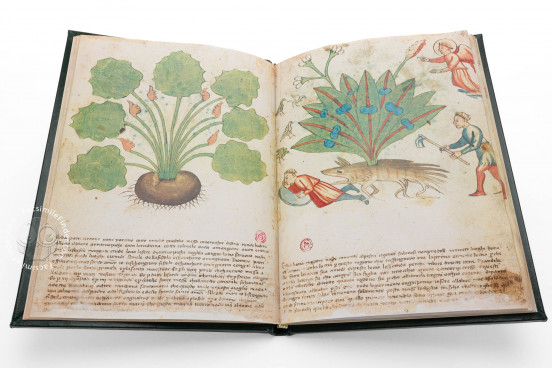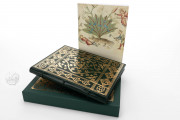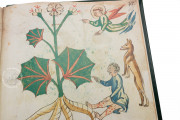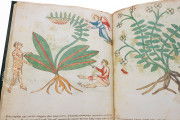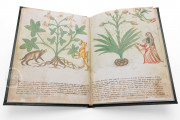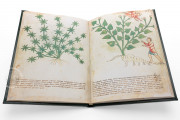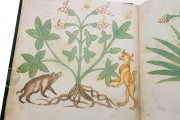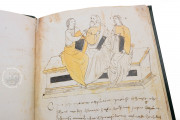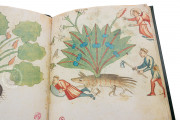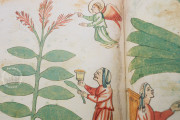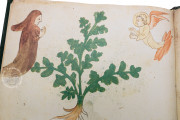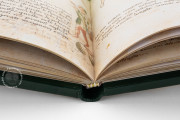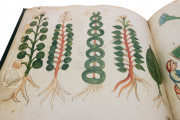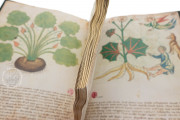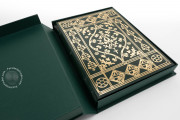Ghino's Herbal, named for the person who compiled the information and wrote the book for his own use, was made between 1430 and 1449 presumably in Florence. It is a picture book of medicinal plants dominated by large watercolors of the plant specimens. The anonymous artist—presumably someone other than Ghino whom he employed to execute the paintings—drew on the pictorial tradition for the ninety paintings of the plants themselves but enlivened them with small human, animal, superhuman, and fantastic figures of great charm and variety.
For each plant—which is accorded a page in the manuscript—Ghino discusses its name, its curative properties, how it is to be prepared for medicinal use (whether ground or mixed with wine, oil, honey, or water), optimal growing conditions, and best time for harvesting.
Detailed Watercolors of Specimens
Each plant appears in its entirety, revealing not only the shape of its leaves and flowers but also its root structure. The roots often take the form of animals or humans: for example, a pike fish for snowy wood rush (fol. 4r), a serpent for viper's bugloss (fol. 17v), and hairy humans for mandrakes (fols. 5r, 5v, 15v).
Large Plants and Little People
Ghino's Herbal is remarkable for the characters, smaller in scale, that surround the central depictions of the plant specimens. These include angels pointing (indicative of an herb's healing properties), demons escaping those being cured (e.g., on fol. 35r), a centaur (fol. 7v), a pharmacist (fol. 33v), a surgeon (fol. 25v), a soldier with spear and shield (fol. 34v), and animals (on fols. 15v, 23r, 23v, and 45r).
A Group Portrait
The book opens with a portrait of Hippocrates (fourth century BCE) flanked by Dioscorides Pedanius (first century CE) and Apuleius (second century CE), admired by early modern scholars as classical authorities on medicine (fol. 1r). Each holds a large book, every bit as big as the book in which they are pictured. There is little color, but it is sensitively applied, with ocher coloring the inner garments of two of the protagonists and the pallium of the third.
Cures for What Ails You
Most of the human figures in the paintings represent people suffering from complaints that the plants promise to cure. On the page for knapweed, for example, a man bitten on the leg by a snake illustrates the plant's antivenom capacity (fol. 6v). The page for a plant of uncertain identification that is reported to cure inflammations of the urinary tract includes a man, naked except for a fancy cap, urinating (fol. 22v).
Maestro Ghino
Given its large format, Ghino's Herbal was not intended as a field guide, but it is a practical manual, as well as an attractive book. An added inscription states that a now lost torn page recorded that "Maestro Ghino" compiled the text (fol. 1r). He is assumed to be the main scribe of this, his personal herbal.
Ghino wrote the extended picture captions across the bottom of each page in long lines (a single column) in a workaday Gothic Hybrida. He wrote after the paintings were made, unless he anticipated that secondary images would occupy the lower right corners of some pages (fols. 25v, 29v, and 40r). Another scribe emended his text.
From the Collection of a Famous Scientist
Celebrated biologist Francesco Redi (1626-1698) once owned the manuscript, which was among 216 manuscripts his family bequeathed to the Laurentian Library in 1820.
We have 1 facsimile edition of the manuscript "Ghino's Herbal": Segreti e Virtù delle Erbe - Erbario Mediceo facsimile edition, published by Imago, 2021
Request Info / Price
